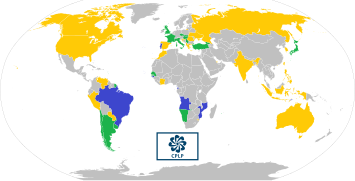Portuguese Empire
| History of Portugal |
|---|
 |
| Timeline |
|
|
The Portuguese Empire (
The Portuguese Empire originated at the beginning of the Age of Discovery, and the power and influence of the Kingdom of Portugal would eventually expand across the globe. In the wake of the Reconquista, Portuguese sailors began exploring the coast of Africa and the Atlantic archipelagos in 1418–1419, using recent developments in navigation, cartography, and maritime technology such as the caravel, with the aim of finding a sea route to the source of the lucrative spice trade. In 1488, Bartolomeu Dias rounded the Cape of Good Hope, and in 1498 Vasco da Gama reached India. In 1500, either by an accidental landfall or by the crown's secret design, Pedro Álvares Cabral reached what would be Brazil.
Over the following decades, Portuguese sailors continued to explore the coasts and islands of East Asia, establishing forts and factories as they went. By 1571, a string of naval outposts connected Lisbon to Nagasaki along the coasts of Africa, the Middle East, India, and South Asia. This commercial network and the colonial trade had a substantial positive impact on Portuguese economic growth (1500–1800) when it accounted for about a fifth of Portugal's per-capita income.
When
The third era of empire covers the final stage of Portuguese colonialism after the independence of Brazil in the 1820s. By then, the colonial possessions had been reduced to forts and plantations along the African coastline (expanded inland during the Scramble for Africa in the late 19th century), Portuguese Timor, and enclaves in India (Portuguese India) and China (Portuguese Macau). The 1890 British Ultimatum led to the contraction of Portuguese ambitions in Africa.
Under
History and colonisation
Background (1139–1415)
The origin of the Kingdom of Portugal lay in the reconquista, the gradual reconquest of the Iberian peninsula from the Moors.[4] After establishing itself as a separate kingdom in 1139, Portugal completed its reconquest of Moorish territory by reaching Algarve in 1249, but its independence continued to be threatened by neighbouring Castile until the signing of the Treaty of Ayllón in 1411.[5]
Free from threats to its existence and unchallenged by the wars fought by other European states, Portuguese attention turned overseas and towards a military expedition to the Muslim lands of North Africa.
In 1415 an attack was made on
First empire (1415–1663)
Although Ceuta proved to be a disappointment for the Portuguese, the decision was taken to hold it while exploring along the Atlantic African coast.
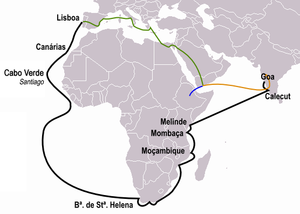
Soon its ships were bringing into the European market highly valued gold, ivory, pepper, cotton, sugar, and slaves. The slave trade, for example, was conducted by a few dozen merchants in Lisbon. In the process of expanding the trade routes, Portuguese navigators mapped unknown parts of Africa, and began exploring the Indian Ocean. In 1487, an overland expedition by Pêro da Covilhã made its way to India, exploring trade opportunities with the Indians and Arabs, and winding up finally in Ethiopia. His detailed report was eagerly read in Lisbon, which became the best informed center for global geography and trade routes.[14]
Initial African coastline excursions
Fears of what lay beyond

The first
Expansion of sugarcane in Madeira started in 1455, using advisers from Sicily and (largely) Genoese capital to produce the "sweet salt" rare in Europe. Already cultivated in Algarve, the accessibility of Madeira attracted Genoese and Flemish traders keen to bypass Venetian monopolies. Slaves were used, and the proportion of imported slaves in Madeira reached 10% of the total population by the 16th century.[21] By 1480 Antwerp had some seventy ships engaged in the Madeira sugar trade, with the refining and distribution concentrated in Antwerp. By the 1490s Madeira had overtaken Cyprus as a producer of sugar.[22] The success of sugar merchants such as Bartolomeo Marchionni would propel the investment in future travels.[23]
In 1469, after prince Henry's death and as a result of meagre returns of the African explorations, King

In 1488,
As the Portuguese explored the coastlines of Africa, they left behind a series of padrões, stone crosses engraved with the Portuguese coat of arms marking their claims,[30] and built forts and trading posts. From these bases, they engaged profitably in the slave and gold trades. Portugal enjoyed a virtual monopoly on the African seaborne slave trade for over a century, importing around 800 slaves annually. Most were brought to the Portuguese capital Lisbon, where it is estimated black Africans came to constitute 10 percent of the population.[31]
Treaty of Tordesillas (1494)
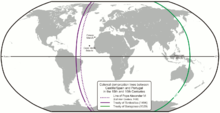
Christopher Columbus's 1492 discovery for Spain of the New World, which he believed to be Asia, led to disputes between the Spanish and the Portuguese.[32] These were eventually settled by the Treaty of Tordesillas in 1494, which divided the world outside of Europe in an exclusive duopoly between the Portuguese and the Spanish along a north–south meridian 370 leagues, or 970 miles (1,560 km), west of the Cape Verde islands.[33] However, as it was not possible at the time to correctly measure longitude, the exact boundary was disputed by the two countries until 1777.[34]
The completion of these negotiations with Spain is one of several reasons proposed by historians for why it took nine years for the Portuguese to follow up on Dias's voyage to the Cape of Good Hope, though it has also been speculated that other voyages were in fact taking place in secret during this time.
The Portuguese enter the Indian Ocean

The squadron of Vasco da Gama left Portugal in 1497, rounded the Cape and continued along the coast of East Africa, where a local pilot was brought on board who guided them across the Indian Ocean, reaching Calicut, the capital of the kingdom ruled by Zamorins, also known as Kozhikode) in south-western India in May 1498.[38] The second voyage to India was dispatched in 1500 under Pedro Álvares Cabral. While following the same south-westerly route as Gama across the Atlantic Ocean, Cabral made landfall on the Brazilian coast. This was probably an accidental discovery, but it has been speculated that the Portuguese secretly knew of Brazil's existence and that it lay on their side of the Tordesillas line.[39] Cabral recommended to the Portuguese King that the land be settled, and two follow up voyages were sent in 1501 and 1503. The land was found to be abundant in pau-brasil, or brazilwood, from which it later inherited its name, but the failure to find gold or silver meant that for the time being Portuguese efforts were concentrated on India.[40] In 1502, to enforce its trade monopoly over a wide area of the Indian Ocean, the Portuguese Empire created the cartaz licensing system, granting merchant ships protection against pirates and rival states.[41]

Profiting from the rivalry between the

A Portuguese fleet under the command of

Although requested by Manuel I to further explore interests in Malacca and Sri Lanka, Almeida instead focused on western India, in particular the
Along with Almeida's initial attempts, Manuel I and his council in Lisbon had tried to distribute power in the Indian Ocean, creating three areas of jurisdiction: Albuquerque was sent to the Red Sea, Diogo Lopes de Sequeira to South-east Asia, seeking an agreement with the Sultan of Malacca, and Jorge de Aguiar followed by Duarte de Lemos were sent to the area between the Cape of Good Hope and Gujarat.[50] However, such posts were centralized by Afonso de Albuquerque after his succession and remained so in subsequent ruling.[51]
-
Portuguese discoveries and explorations: first arrival places and dates; main Portuguese spice traderoutes (blue)
-
16th century Portuguese illustration from the Códice Casanatense, depicting a Portuguese nobleman with his retinue in India
-
16th century heavy Portuguese carrack.
Trade with Maritime Asia, Africa and the Indian Ocean
Goa, Malacca and Southeast Asia
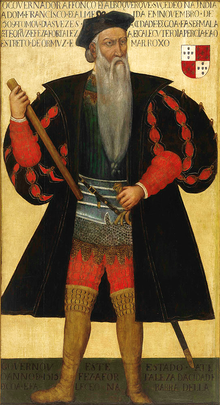

By the end of 1509, Albuquerque became viceroy of the
In April 1511, Albuquerque sailed to
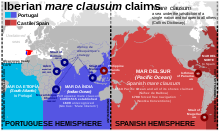
The Malacca peninsula became the strategic base for Portuguese trade expansion with China and Southeast Asia. A strong gate, called the A Famosa, was erected to defend the city and remains.[62] Learning of Siamese ambitions over Malacca, Albuquerque immediately sent Duarte Fernandes on a diplomatic mission to the Kingdom of Siam (modern Thailand), where he was the first European to arrive, establishing amicable relations and trade between both kingdoms.[63][64]
The Portuguese empire pushed further south and proceeded to discover Timor in 1512.
China and Japan

Jorge Alvares was the first European to reach China by sea, while the Romans were the first overland via Asia Minor.[69][70][71][72] He was also the first European to discover Hong Kong.[73][74] In 1514, Afonso de Albuquerque, the Viceroy of the Estado da India, dispatched Rafael Perestrello to sail to China in order to pioneer European trade relations with the nation.[75][76]
In their first attempts at obtaining trading posts by force, the Portuguese were defeated by the Ming Chinese at the

Despite initial harmony and excitement between the two cultures, difficulties began to arise shortly afterwards, including misunderstanding, bigotry, and even hostility.[78] The Portuguese explorer Simão de Andrade incited poor relations with China due to his pirate activities, raiding Chinese shipping, attacking a Chinese official, and kidnappings of Chinese. He based himself at Tamao island in a fort. The Chinese claimed that Simão kidnapped Chinese boys and girls to be molested and cannibalized.[79] The Chinese sent a squadron of junks against Portuguese caravels that succeeded in driving the Portuguese away and reclaiming Tamao. As a result, the Chinese posted an edict banning men with Caucasian features from entering Canton, killing multiple Portuguese there, and driving the Portuguese back to sea.[80][81]
After the Sultan of Bintan detained several Portuguese under Tomás Pires, the Chinese then executed 23 Portuguese and threw the rest into prison where they resided in squalid, sometimes fatal conditions. The Chinese then massacred Portuguese who resided at
Spice Islands (Moluccas) and Treaty of Zaragoza

Portuguese operations in Asia did not go unnoticed, and in 1521
South Asia, Persian Gulf and Red Sea


The Portuguese empire expanded into the Persian Gulf, contesting control of the spice trade with the
In 1534, Gujarat faced attack from the
Sub-Saharan Africa
After a series of prolonged contacts with Ethiopia, the Portuguese embassy made contact with the
The Portuguese also made direct contact with the Kongolose vassal state Ndongo and its ruler Ngola Kiljuane in 1520, after the latter requested missionaries.[99] Kongolese king Afonso I interfered with the process with denunciations, and later sent a Kongo mission to Ndongo after the latter had arrested the Portuguese mission that came.[99] The growing official and unofficial slave trading with Ndongo strained relations between Kongo and the Portuguese, and even had Portuguese ambassadors from Sao Tome support Ndongo against the Kingdom of Kongo.[100][101] However, when the Jaga attacked and conquered regions of Kongo in 1568, Portuguese assisted Kongo in their defeat.[102] In response, the Kongo allowed the colonization of Luanda Island; Luanda was established by Paulo Dias de Novais in 1576 and soon became a slave port.[102][103] De Novais' subsequent alliance with Ndongo angered Luso-Africans who resented the influence from the Crown.[104] In 1579, Ndongo ruler Ngola Kiluanje kia Ndamdi massacred Portuguese and Kongolese residents in the Ndongo capital Kabasa under the influence of Portuguese renegades. Both the Portuguese and Kongo fought against Ndongo, and off-and-on warfare between the Ndongo and Portugal would persist for decades.[105]
In east-Africa, the main agents acting on behalf of the Portuguese Crown, exploring and settling the territory of what would become Mozambique were the prazeiros, to whom vast estates around the Zambezi river were leased by the King as a reward for their services. Commanding vast armies of chikunda warrior-slaves, these men acted as feudal-like lords, either levying tax from local chieftains, defending them and their estates from marauding tribes, participating in the ivory or slave trade, and becoming involved in the politics of the Kingdom of Mutapa, to the point of installing client kings upon its throne.
Missionary expeditions
In 1542, Jesuit missionary
Guarding its trade from both European and Asian competitors, Portugal dominated not only the trade between Asia and Europe, but also much of the trade between different regions of Asia and Africa, such as India, Indonesia, China, and Japan.
Colonization efforts in the Americas
Canada
Based on the Treaty of Tordesillas, the Portuguese Crown, under the kings Manuel I, John III and Sebastian, also claimed territorial rights in North America (reached by John Cabot in 1497 and 1498). To that end, in 1499 and 1500, João Fernandes Lavrador explored Greenland and the north Atlantic coast of Canada, which accounts for the appearance of "Labrador" on topographical maps of the period.[112] Subsequently, in 1500–1501 and 1502, the brothers Gaspar and Miguel Corte-Real explored what is today the Canadian province of Newfoundland and Labrador, and Greenland, claiming these lands for Portugal. In 1506, King Manuel I created taxes for the cod fisheries in Newfoundland waters.[citation needed] Around 1521, João Álvares Fagundes was granted donatary rights to the inner islands of the Gulf of St. Lawrence and also created a settlement on Cape Breton Island to serve as a base for cod fishing. Pressure from natives and competing European fisheries prevented a permanent establishment and it was abandoned five years later. Several attempts to establish settlements in Newfoundland over the next half-century also failed.[113]
Brazil
Within a few years after Cabral arrived from Brazil, competition came along from France. In 1503, an expedition under the command of
The increase in brazilwood smuggling from the French led
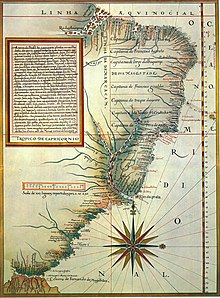
Upon de Sousa's arrival and success, fifteen latitudinal tracts, theoretically to span from the coast to the Tordesillas limit, were decreed by João III on 28 September 1532.
Of the fifteen original captaincies, only two,
Tomé de Sousa built the capital of Brazil,
The Tamoio had been allied with the French since the settlement of France Antarctique, and despite the French loss in 1560, the Tamoio were still a threat.
Iberian Union, Protestant rivalry, and colonial stasis (1580–1663)
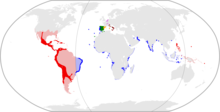
In 1580, King
The Tordesillas boundary between Spanish and Portuguese control in South America was then increasingly ignored by the Portuguese, who pressed beyond it into the heart of Brazil,[142] allowing them to expand the territory to the west. Exploratory missions were carried out both ordered by the government, the "entradas" (entries), and by private initiative, the "bandeiras" (flags), by the "bandeirantes".[145] These expeditions lasted for years venturing into unmapped regions, initially to capture natives and force them into slavery, and later focusing on finding gold, silver and diamond mines.[146]
However, the union meant that Spain dragged Portugal into its conflicts with England, France and the

Spanish imperial trade networks now were opened to Portuguese merchants, which was particularly lucrative for Portuguese slave traders who could now sell slaves in Spanish America at a higher price than could be fetched in Brazil.
In 1592, during the war with Spain, an English fleet captured a large Portuguese carrack off the Azores, the Madre de Deus, which was loaded with 900 tons of merchandise from India and China estimated at half a million pounds (nearly half the size of English Treasury at the time).[152] This foretaste of the riches of the East galvanized English interest in the region.[153] That same year, Cornelis de Houtman was sent by Dutch merchants to Lisbon, to gather as much information as he could about the Spice Islands.[151][154]
The Dutch eventually realized the importance of Goa in breaking up the Portuguese empire in Asia. In 1583, merchant and explorer

The Dutch took their fight overseas, attacking Spanish and Portuguese colonies and beginning the
Meanwhile, in the Persian Gulf region, the Portuguese also lost control of
Second empire (1663–1822)

The loss of colonies was one of the reasons that contributed to the end of the personal union with Spain. In 1640 John IV was proclaimed King of Portugal and the Portuguese Restoration War began. Even before the war's final resolution, the crown established the Overseas Council, conceived in 1642 on the short-lived model of the Council of India (1604–1614), and established in 1643, it was the governing body for most of the Portuguese overseas empire. The exceptions were North Africa, Madeira, and the Azores. All correspondence concerning overseas possessions were funneled through the council. When the Portuguese court fled to Brazil in 1807, following the Napoleonic invasion of Iberia, Brazil was removed from the jurisdiction of the council. It made recommendations concerning personnel for the administrative, fiscal, and military, as well as bishops of overseas dioceses.[166] A distinguished seventeenth-century member was Salvador de Sá.[167]

In 1661 the Portuguese offered
After the Portuguese were defeated by the Indian rulers
Minas Gerais and the gold industry
In 1693, gold was discovered at
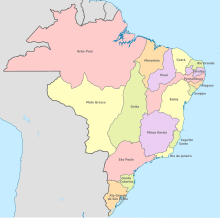
The gold rush considerably increased the revenue of the Portuguese crown, who charged a fifth of all the ore mined, or the "fifth". Diversion and smuggling were frequent, along with altercations between Paulistas (residents of São Paulo) and Emboabas (immigrants from Portugal and other regions in Brazil), so a whole set of bureaucratic controls began in 1710 with the captaincy of São Paulo and Minas Gerais. By 1718, São Paulo and Minas Gerais became two captaincies, with eight vilas created in the latter.[174][175] The crown also restricted the diamond mining within its jurisdiction and to private contractors.[175] In spite of gold galvanizing global trade, the plantation industry became the leading export for Brazil during this period; sugar constituted at 50% of the exports (with gold at 46%) in 1760.[173]
Africans became the largest group of people in Minas Gerais. Slaves labeled as 'Minas' and 'Angolas' rose in high demand during the boom. The
Gold discovered in Mato Grosso and Goiás sparked an interest to solidify the western borders of the colony. In the 1730s contact with Spanish outposts occurred more frequently, and the Spanish threatened to launch a military expedition in order to remove them. This failed to happen and by the 1750s the Portuguese were able to implant a political stronghold in the region.[177]
In 1755 Lisbon suffered a catastrophic earthquake, which together with a subsequent tsunami killed between 40,000 and 60,000 people out of a population of 275,000.[178] This sharply checked Portuguese colonial ambitions in the late 18th century.[179]
According to economic historians, Portugal's colonial trade had a substantial positive impact on Portuguese economic growth, 1500–1800. Leonor Costa et al. conclude:
intercontinental trade had a substantial and increasingly positive impact on economic growth. In the heyday of colonial expansion, eliminating the economic links to empire would have reduced Portugal's per capita income by roughly a fifth. While the empire helped the domestic economy it was not sufficient to annul the tendency towards decline in relation to Europe's advanced core which set in from the 17th century onwards.[180]
Pombaline and post-Pombaline Brazil

Unlike Spain, Portugal did not divide its
Encouraged by the example of the United States of America, which had won its independence from Britain, the colonial province of Minas Gerais attempted to achieve the same objective in 1789. However, the Inconfidência Mineira failed, its leaders were arrested, and of the participants in the insurrections, the one of lowest social position, Tiradentes, was hanged.[185] Among the conspiracies led by the African population was the Bahian revolt in 1798, led primarily by João de Deus do Nascimento. Inspired by the French Revolution, leaders proposed a society without slavery, food prices would be lowered, and trade restriction abolished. Impoverished social conditions and a high cost of living were among reasons of the revolt. Authorities diffused the plot before major action began; they executed four of the conspirators and exiled several others to the Atlantic Coast of Africa.[186] Several more smaller-scale slave rebellions and revolts would occur from 1801 and 1816 and fears within Brazil were that these events would lead to a "second Haiti".[187]
In spite of the conspiracies, the rule of Portugal in Brazil was not under serious threat. Historian A. R. Disney states that the colonists did not until the transferring of the Kingdom in 1808 assert influence of policy changing due to direct contact,[188] and historian Gabriel Paquette mentions that the threats in Brazil were largely unrealized in Portugal until 1808 because of effective policing and espionage.[189] More revolts would occur after the arrival of the court.[190]
Brazilian Independence
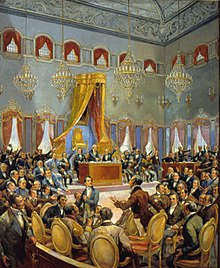
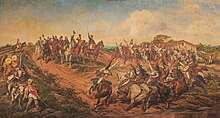
In 1808,
Although the royal family returned to Portugal in 1821, the interlude led to a growing desire for independence amongst Brazilians. In 1822, the son of Dom João VI, then prince-regent
Third empire (1822–1999)

At the height of
British Ultimatum and end of Portuguese monarchy (1890–1910)

The project to connect the two colonies, the
The King's reaction to the ultimatum was exploited by republicans.[196] On February 1, 1908, King Carlos and Prince Luís Filipe were assassinated in Lisbon by two Portuguese republican activist revolutionaries, Alfredo Luís da Costa and Manuel Buíça. Luís Filipe's brother, Manuel, became King Manuel II of Portugal. Two years later, on October 5, 1910, he was overthrown and fled into exile in England in Fulwell Park, Twickenham near London and Portugal became a republic.[197]
World War I
In 1914, the German Empire formulated plans to usurp Angola from Portuguese control.[198] Skirmishes between Portuguese and German soldiers ensued, resulting in reinforcements being sent from the mainland.[199] The main objective of these soldiers was to recapture the Kionga Triangle, in northern Mozambique, the territory having been subjugated by Germany. In 1916, after Portugal interned German ships in Lisbon, Germany declared war on Portugal. Portugal followed suit, thus entering World War I.[200] Early in the war, Portugal was involved mainly in supplying the Allies positioned in France. In 1916, there was only one attack on the Portuguese territory, in Madeira.[201] In 1917, one of the actions taken by Portugal was to assist Britain in its timber industry, imperative to the war effort. Along with the Canadian Forestry Corps, Portuguese personnel established logging infrastructure in an area now referred to as the "Portuguese Fireplace".[202]
Throughout 1917 Portugal dispatched contingents of troops to the Allied front in France. Midway in the year, Portugal suffered its first World War I casualty. In Portuguese Africa, Portugal and the British fought numerous battles against the Germans in both Mozambique and Angola. Later in the year,
Portuguese territories in Africa eventually included the modern nations of Cape Verde, São Tomé and Príncipe, Guinea-Bissau, Angola, and Mozambique.[205]
Decolonization (1954–1999)

In the wake of
The outbreak of violence in February 1961 in Angola was the beginning of the end of Portugal's empire in Africa. Portuguese army officers in Angola held the view that it would be incapable of dealing militarily with an outbreak of guerilla warfare and therefore that negotiations should begin with the independence movements. However, Salazar publicly stated his determination to keep the empire intact, and by the end of the year, 50,000 troops had been stationed there. The same year, the tiny Portuguese fort of São João Baptista de Ajudá in Ouidah, a remnant of the West African slave trade, was annexed by the new government of Dahomey (now Benin) that had gained its independence from France. Unrest spread from Angola to Guinea, which rebelled in 1963, and Mozambique in 1964.[208]
According to one historian, Portuguese rulers were unwilling to meet the demands of their colonial subjects (unlike other European powers) in part because Portuguese elites believed that "Portugal lacked the means to conduct a successful "exit strategy" (akin to the "neocolonial" approach followed by the British, the French, or the Belgians)" and in part due to the lack of "a free and open debate [in Salazar's dictatorial state] on the costs of upholding an empire against the anti-colonial consensus that had prevailed in the United Nations since the early 1960s".[209] The rise of Soviet influence among the
Civil wars in
In 1987, Portugal signed the
Legacy

Presently, the
Macau was returned to China on 20 December 1999, under the terms of an agreement negotiated between People's Republic of China and Portugal twelve years earlier. Nevertheless, the Portuguese language remains co-official with
Currently, the Azores and Madeira (the latter administering the uninhabited Savage Islands) are the only overseas territories that remain politically linked to Portugal. Although Portugal began the process of decolonizing East Timor in 1975, during 1999–2002 was sometimes considered Portugal's last remaining colony, as the Indonesian invasion of East Timor was not justified by Portugal.[218]
Eight of the former colonies of Portugal have
Today, Portuguese is one of the world's major languages, ranked sixth overall with approximately 240 million speakers around the globe.[221] It is the third most spoken language in the Americas, mainly due to Brazil, although there are also significant communities of Lusophones in nations such as Canada, the US and Venezuela. In addition, there are numerous Portuguese-based creole languages, including the one utilized by the Kristang people in Malacca.[222]
For instance, as Portuguese merchants were presumably the first to introduce the
In light of its international importance, Portugal and Brazil are leading a movement to include Portuguese as one of the official languages of the United Nations.[225]
-
Map of the Community of Portuguese Language Countries; member states (blue), associate observers (green), and officially-interested countries & territories (gold)
-
Actual possessions
Explorations
Areas of influence and trade
Claims of sovereignty
Trading posts
Main sea explorations, routes and areas of influence -
The Se Cathedral in Goa, India, an example of Portuguese architecture and one of Asia's largest churches.
-
Pillar of Vasco da Gama at Malindi, Kenya.
See also
- Portuguese colonial architecture
- Edict of Expulsion
- Evolution of the Portuguese Empire
- Goan Inquisition
- List of topics on the Portuguese Empire in the East
- Lusotropicalism
- Persecution of Jews and Muslims by Manuel I of Portugal
- Portuguese Armadas
- Portuguese in Africa
- Portuguese Inquisition
- Portuguese inventions
- Portuguese Surinamese
- Strait of Magellan
References
Citations
- ^ Page & Sonnenburg 2003, p. 481
- ^ Brockey 2008, p. xv
- ^ Juang & Morrissette 2008, p. 894
- ^ Diffie & Winius 1977, p. 301
- ^ Newitt 2005, pp. 15–17
- ^ a b Newitt 2005, p. 19
- ^ a b Boxer 1969, p. 19
- ^ Abernethy, p. 4
- ^ Newitt 2005, p. 21
- ^ a b Diffie & Winius 1977, p. 55
- ^ Diffie & Winius 1977, p. 56: Henry, a product of 15th-century Portugal, was inspired by both religious and economic factors.
- ^ Anderson 2000, p. 50
- ^ Coates 2002, p. 60
- ^ L.S. Stavrianos, The World since 1500: a Global history (1966) pp. 92–93
- ^ Diffie & Winius 1977, p. 68
- ^ Daus 1983, p. 33
- ^ Boxer 1969, p. 29
- ^ Russell-Wood 1998, p. 9
- ^ Rodriguez 2007, p. 79
- ^ Diffie & Winius 1977, p. 469
- ^ Godinho, V. M. Os Descobrimentos e a Economia Mundial, Arcádia, 1965, Vol 1 and 2, Lisboa
- ^ Ponting 2000, p. 482
- ^ Davis 2006, p. 84
- ^ Bethencourt & Curto 2007, p. 232
- ^ White 2005, p. 138
- ^ Gann & Duignan 1972, p. 273
- ^ Diffie & Winius 1977, p. 156
- ^ Diffie & Winius 1977, p. 161.
- ^ Anderson 2000, p. 59
- ^ Newitt 2005, p. 47
- ^ Anderson 2000, p. 55
- ^ McAlister 1984, pp. 73–75
- ^ Bethencourt & Curto 2007, p. 165
- ^ Diffie & Winius 1977, p. 174
- ^ Diffie & Winius 1977, p. 176
- ^ Boxer 1969, p. 36
- ^ Diffie & Winius 1977, pp. 176–185
- ^ Scammell, p. 13
- ^ McAlister 1984, p. 75
- ^ McAlister 1984, p. 76
- ^ Diffie & Winius 1977, pp. 274, 320–323
- ^ "Thangasseri, Kollam, Dutch Quilon, Kerala". Kerala Tourism. Archived from the original on 2014-05-14. Retrieved 2014-09-01.
- ^ Bethencourt & Curto 2007, p. 207
- ^ Abeyasinghe 1986, p. 2
- ^ Disney 2009b, p. 128
- ^ Diffie & Winius 1977, pp. 233, 235
- ^ Macmillan 2000, p. 11
- ^ Diffie & Winius 1977, pp. 237–239
- ^ a b Disney 2009b, pp. 128–129
- ^ Diffie & Winius 1977, pp. 245–247
- ^ Subrahmanyam 2012, pp. 67–83
- ^ Disney 2009b, p. 129
- ^ Diffie & Winius 1977, p. 238
- ^ Shastry 2000, pp. 34–45
- ^ a b Disney 2009b, p. 130
- ^ de Souza 1990, p. 220
- ^ Mehta 1980, p. 291
- ^ Ricklefs 1991, p. 23
- ^ a b Kratoska 2004, p. 98
- ^ Gipouloux 2011, pp. 301–302
- ^ Newitt 2005, p. 78
- ^ Ooi 2009, p. 202
- ^ Lach 1994, pp. 520–521
- ^ Encyclopedia of the Peoples of Asia and Oceania by Barbara A. West. Infobase Publishing, 2009. p. 800
- ISBN 978-0-8108-6528-0.
- ^ de Silva Jayasuriya, p. 86
- ]
- ^ de Silva Jayasuriya, p. 87
- ISBN 978-0-521-24333-9.
- ISBN 978-0-521-52403-2.
- ISBN 978-0-19-531391-8.
- ISBN 978-0-7787-2493-3.
- ^ Hong Kong & Macau 14 By Andrew Stone, Piera Chen, Chung Wah Chow Lonely Planet, 2010. pp. 20–21
- ^ Hong Kong & Macau By Jules Brown Rough Guides, 2002. p. 195
- ^ "Tne Portuguese in the Far East". Algarvedailynews.com. Archived from the original on 2013-01-30. Retrieved 2013-04-18.
- ^ "'Portugal's Discovery in China' on Display". www.china.org.cn. Archived from the original on 2022-05-15. Retrieved 2013-05-03.
- ISBN 0-521-24333-5
- ^ "When Portugal Ruled the Seas | History & Archaeology | Smithsonian Magazine". Smithsonianmag.com. Archived from the original on 2012-12-25. Retrieved 2013-04-18.
- ^ Jesus 1902, p. 5
- ^ a b c Dodge 1976, p. 226
- ^ Whiteway 1899, p. 339
- ^ Disney 2009b, pp. 175, 184
- ISBN 978-0-8264-6074-5.
- ^ Ooi 2004, p. 1340
- ^ Juan Cole, Sacred Space and Holy War, IB Tauris, 2007 p. 37
- ^ O'Flanagan 2008, p. 125
- ^ a b Pearson 1976, pp. 74–82
- ^ Malekandathil 2010, pp. 116–118
- ^ Mathew 1988, p. 138
- ISBN 0275988767.
- ^ D. João de Castro The Voyage of Don Stefano de Gama from Goa to Suez, in 1540, with the intention of Burning the Turkish Galleys at that port Archived 2006-10-14 at the Wayback Machine (Volume 6, Chapter 3, eText)
- ^ a b Abir, p. 86
- ^ Appiah; Gates, p. 130
- ^ Chesworth; Thomas p. 86
- ^ Newitt (2004), p. 86
- ^ Black, p. 102
- ^ Stapleton 2013, p. 121
- ^ Cohen, pp. 17–18
- ^ a b Mancall 2007, p. 207
- ^ Thornton 2000, pp. 100–101
- ^ Heywood & Thornton 2007, p. 83
- ^ a b Stapleton 2013, p. 175
- ^ Goodwin, p. 184
- ^ Heywood & Thornton 2007, p. 86
- ^ Mancall 2007, pp. 208–211
- ISBN 978-0-262-66072-3.
- ISBN 0-415-32379-7.
- ^ Disney 2009b, p. 195
- ISBN 9780190615093.
- ISBN 9780275968960.
the Church of England was a " state church " in the colonies the way it indisputably was in England, and as the Roman Catholic Church was in the neighboring Spanish and Portuguese empires.
- ^ Bethencourt & Curto 2007, pp. 262–265
- ^ Diffie & Winius 1977, p. 464
- ^ Disney 2009a, p. 116
- ^ Herring & Herring 1968, p. 214
- ^ Metcalf (2006), p. 60
- ^ a b c Pickett & Pickett 2011, p. 14
- ^ Marley 2008, p. 76
- ^ Marley 2008, pp. 76–78
- ^ a b de Oliveira Marques 1972, p. 254
- ^ Marley 2008, p. 78
- ^ Marley 2005, pp. 694–696
- ^ Marley 2008, p. 694
- ^ Diffie & Winius 1977, p. 310
- ISBN 978-0-19-802631-0. Retrieved 10 July 2012.
- ^ de Oliveira Marques 1972, pp. 255–56
- ^ de Oliveira Marques 1972, p. 255
- ^ Bethencourt & Curto 2007, pp. 111–119
- ^ Lockhart 1983, pp. 190–191
- ^ Bakewell 2009, p. 496
- ^ Mahoney 2010, p. 246
- ^ Russell-Wood 1968, p. 47
- ^ Ladle 2000, p. 185
- ^ Metcalf (2005), pp. 36–37
- ^ a b Marley 2008, p. 86
- ^ Marley 2008, p. 90
- ^ a b c Treece 2000, p. 31
- ^ a b Marley 2008, pp. 91–92
- ^ Metcalf (2005), p. 37
- ^ Marley 2008, p. 96
- ^ Schwartz 1973, p. 41
- ^ Kamen 1999, p. 177
- ^ a b Boyajian 2008, p. 11
- ^ Gallagher 1982, p. 8
- ^ Anderson 2000, pp. 104–105
- ^ Boxer 1969, p. 386
- ^ a b Bethencourt & Curto 2007, pp. 111, 117
- ^ Anderson 2000, p. 105
- ^ Thomas 1997, p. 159
- ^ Lockhart 1983, p. 250
- ^ Newitt 2005, p. 163
- ^ a b Disney 2009b, p. 186
- ^ Smith, Roger (1986). "Early Modern Ship-types, 1450–1650". The Newberry Library. Archived from the original on 2008-07-20. Retrieved 2009-05-08.
- .
- ^ Lach 1994, p. 200
- ^ Van Linschoten, Jan Huygen (1596), Itinerario, Voyage ofte Schipvaert (in Dutch), Amsterdam: Cornelis Claesz.
- ^ Burnell, Arthur Coke; et al., eds. (1885), The Voyage of John Huyghen van Linschoten to the East Indies..., London: Hakluyt Society.
- ISBN 978-0-520-07723-2. Retrieved 10 July 2012.
- ISBN 978-1-84383-073-3. Retrieved 10 July 2012.
- ^ Disney 2009b, pp. 73–74, 168–171, 226–231
- ^ Charles R. Boxer, The Dutch in Brazil, 1624–1654. Oxford: Clarendon Press 1957.
- ^ Disney 2009b, p. 169
- ^ Willem Floor, "Dutch Relations with the Persian Gulf", in Lawrence G. Potter (ed.), The Persian Gulf in History (Palgrave Macmillan, 2009), p. 240.
- ^ Disney 2009b, p. 350
- ISBN 978-0313262579. Retrieved 2017-08-27.
- ISBN 978-0700712205. Retrieved 2017-08-27.
- ^ Francis A. Dutra. "Overseas Council (Portugal)" in Encyclopedia of Latin American History and Culture, vol. 4, pp. 254–255. New York: Charles Scribner's Sons 1996.
- ^ Francis A. Dutra, "Salvador Correia de Sá e Benavides" in Encyclopedia of Latin American History and Culture, vol. 5, p. 2. New York: Charles A. Scribner's Sons 1996.
- ISBN 0-8122-1845-0. Retrieved 10 July 2012.
- ^ History of the Konkan by Alexander Kyd Nairne pp. 84–85
- ^ Ahmed 2011, p. 330
- ISSN 1057-1515(Baywolf Press) p. 35
- ^ Boxer 1969, p. 168
- ^ a b Disney 2009b, pp. 268–269
- ^ Bethell 1985, p. 203
- ^ a b Disney 2009b, pp. 267–268
- ^ Disney 2009b, pp. 273–275
- ^ Disney 2009b, p. 288
- ^ Kozák & Cermák 2007, p. 131
- ISBN 978-81-89422-31-8. Retrieved 10 July 2012.
- hdl:10400.5/26870.
- ^ Disney 2009a, pp. 298–302
- ^ Disney 2009b, pp. 288–289
- ^ Disney 2009b, pp. 277–279, 283–284
- ^ Paquette, p. 67
- ^ Bethell 1985, pp. 163–164
- ^ Disney 2009b, pp. 296–297
- ^ Paquette, p. 104
- ^ Disney 2009b, p. 298
- ^ Pequette, p. 106
- ^ Pequette, pp. 106–114
- ^ Bethell 1985, pp. 177–178
- ^ Angus, William, ed. (1837). History of England: From the Roman Invasion to the Accession of Queen Victoria I. Glasgow. pp. 254–255. Retrieved 10 July 2012.
- ISBN 978-1-4039-6255-3. Retrieved 10 July 2012.
- ^ Newitt 1995, pp. 335–336
- ^ Corrado 2008, p. 18
- ^ a b c Lisboa 2008, p. 134
- ^ Wheeler 1998, pp. 48–61
- S2CID 162822016.
- ^ "Portugal enters the war". The Independent. Oct 26, 1914. Retrieved July 24, 2012.
- ^ Wheeler 1998, p. 128
- ^ Helgason, Guðmundur. "Ships hit during WWI: Dacia". German and Austrian U-boats of World War I - Kaiserliche Marine - Uboat.net.
- ^ "Portuguese Fireplace". Newforestexplorersguide.co.uk. Archived from the original on 2023-06-27. Retrieved 2014-08-06.
- ^ "Battle of La Lys". Archived from the original on June 3, 2007.
- ^ Thomas, H.B., "The Kionga Triangle", Tanganyika Notes and Records Volume 31 1951, pp. 47–50.
- ISBN 978-1-934078-10-5. Retrieved 12 July 2012.
- ^ Pearson 1987, p. 158
- ^ Pearson 1987, p. 160
- ^ a b Anderson 2000, p. 153
- ISBN 9780190277734. Archivedfrom the original on 2021-05-13. Retrieved 2022-03-22.
- Time Magazine(July 7, 1975)
- ^ Travels, Geographic (July 8, 2012). "The Geographical Oddity of Fortaleza de Sao Joao Baptista de Ajuda". Archived from the original on May 29, 2023. Retrieved February 27, 2021.
- ^ Arnold & Wiener 2012, pp. 11–12
- ^ "East Timor: Birth of a nation". Archived from the original on 26 April 2023. Retrieved 12 July 2012.
- ^ "Joint declaration of the Government of the People's Republic of China and The Government of the Republic of Portugal on the question of Macao". Government Printing Bureau (Macao SAR). 1987. Archived from the original on 2011-07-20. Retrieved 2010-04-26.
- ^ Macau and the end of empire Archived 2015-10-16 at the Wayback Machine, 18 December 1999. BBC News
- ^ "CPLP Histórico – Como surgiu?" (in Portuguese). CPLP. Archived from the original on 27 June 2022. Retrieved 16 December 2015.
- ^ "Cataloging Policy and Support Office: Macau". Library of Congress. Archived from the original on 28 June 2022. Retrieved 12 July 2012.
- ^ de Almeida, p. 92
- ^ "CPLP". Archived from the original on 2009-11-27. Retrieved 2010-08-12.
- ^ pt:CPLP
- ^ "língua portuguesa". Archived from the original on 2010-10-12. Retrieved 2010-08-12.
- ^ Velupillai, p. 519
- ^ a b "Multilingual Multiscript Plant Name Database: Sorting Citrus Names". University of Melbourne (www.search.unimelb.edu.au). Archived from the original on 15 May 2013. Retrieved 11 December 2012.
- ISBN 978-1-60918-140-6.
- ^ "ONU: Petição para tornar português língua oficial". Diario.iol.pt. 2005-11-17. Archived from the original on 2009-01-09. Retrieved 2010-04-21.
Explanatory footnotes
General and cited sources
- Abeyasinghe, Tikiri (1986). Jaffna Under the Portuguese. Lake House Investments. ISBN 978-9555520003.
- Abir, Mordechai (1980). Ethiopia and the Red Sea: The Rise and Decline of the Solomonic Dynasty and Muslim European Rivalry in the Region. Routledge. ISBN 978-0714631646.
- Ahmed, Farooqui Salma (2011). A Comprehensive History of Medieval India: Twelfth to the Mid-Eighteenth Century. Pearson Education India. ISBN 978-81-317-3202-1.
- Appiah, Anthony; Gates, Henry Louis, eds. (2010). Encyclopedia of Africa, Volume 2. Oxford University Press. ISBN 9780195337709.
- Arnold, James R.; Wiener, Roberta, eds. (2012). Cold War: The Essential Reference Guide. ABC-CLIO. ISBN 978-1-61069-003-4. Retrieved 12 July 2012.
- Brockey, Liam Matthew (2008). Portuguese Colonial Cities in the Early Modern World. Ashgate Publishing, Ltd. ISBN 978-0-7546-6313-3.
- Abernethy, David (2000). The Dynamics of Global Dominance, European Overseas Empires 1415–1980. Yale University Press. ISBN 0-300-09314-4. Archivedfrom the original on 2023-07-03. Retrieved 2015-06-18.
- Anderson, James Maxwell (2000). The History of Portugal. Greenwood Publishing Group. ISBN 0-313-31106-4.
- Bakewell, Peter (2009). A History of Latin America to 1825. Wiley-Blackwell. ISBN 978-1405183680.
- Bethell, Leslie (1985). The Independence of Latin America. Cambridge University Press. ISBN 978-0-521-34927-7.
- Bethencourt, Francisco; Curto, Diogo Ramada (2007). Portuguese Overseas Expansion, 1400–1800. Cambridge University Press. ISBN 978-0-521-84644-8.
- Black, Jeremy (2011). War in the World: A Comparative History, 1450–1600. Palgrave Macmillan. ]
- ISBN 0-09-131071-7.
- Boyajian, James (2008). Portuguese Trade in Asia Under the Habsburgs, 1580–1640. JHU Press. ISBN 978-0-8018-8754-3.
- Chesworth, John; Thomas, David, eds. (2015). Christian-Muslim Relations. a Bibliographical History.: Volume 7. Central and Eastern Europe, Asia, Africa and South America (1500–1600). Brill Academic Publishers. ISBN 978-9004297203.
- Coates, Timothy Joel (2002). Convicts and Orphans: Forced and State-Sponsored Colonization in the Portuguese Empire, 1550–1755. Stanford University Press. ISBN 9780804733595.
- Cohen, Leonardo (2009). The Missionary Strategies of the Jesuits in Ethiopia (1555–1632). Harrassowitz Verlag. ISBN 978-3-447-05892-6.
- Corrado, Jacopo (2008). The Creole Elite and the Rise of Angolan Protonationalism: 1870–1920. Cambria Press. ISBN 9781604975291.
- Crowley, Roger. Conquerors: How Portugal Forged the First Global Empire (2015)
- Curto, Diogo Ramada. Imperial Culture and Colonial Projects: The Portuguese-Speaking World from the Fifteenth to the Eighteenth Centuries (Berghahn Books, 2020) online review Archived 2022-03-06 at the Wayback Machine
- de Almeida, Miguel Vale (2004). An Earth-colored Sea: Race, Culture And The Politics Of Identity In The Post-colonial Portuguese-speaking World. Berghahn Books. ISBN 978-1-78238-854-8.
- Davies, Kenneth Gordon (1974). The North Atlantic World in the Seventeenth Century. ISBN 0-8166-0713-3.
- ISBN 9780195140736.
- Diffie, Bailey W.; Winius, George D. (1977). Foundations of the Portuguese Empire, 1415–1580. University of Minnesota Press. ISBN 978-0-8166-0782-2.
- Disney, A.R. (2009a). History of Portugal and the Portuguese Empire Volume 1, Portugal: From Beginnings to 1807. Cambridge University Press. ISBN 978-0521843188.
- Disney, A.R. (2009b). History of Portugal and the Portuguese Empire Volume 2, Portugal: From Beginnings to 1807. Cambridge University Press. ISBN 978-0521738224.
- Dodge, Ernest Stanley (1976). Islands and Empires: Western Impact on the Pacific and East Asia. University of Minnesota Press. p. 226. ISBN 978-0816607884.
- Gallagher, Tom (1982). Portugal: A Twentieth Century Interpretation. St. Martin's Press. ISBN 9780719008764.
- Gann, Louis Henry; Duignan, Peter (1972). Africa and the World: An Introduction to the History of Sub-Saharan Africa from Antiquity to 1840. University Press of America. ISBN 978-0-7618-1520-4.
- Gipouloux, François (2011). The Asian Mediterranean: Port Cities and Trading Networks in China, Japan and Southeast Asia, 13th–21st Century. Edward Elger. ISBN 978-0857934260.
- Goodman, Grant K. (2000). Japan and the Dutch 1600-1835. Routledge. ISBN 978-0700712205.
- Goodwin, Stefan (2008). Africa's Legacies Of Urbanization: Unfolding Saga of a Continent. Lexington Books. ISBN 978-0-7391-5176-1.
- Gupta, Pamila. Portuguese Decolonization in the Indian Ocean World: History and Ethnography (Bloomsbury Publishing, 2018).
- Herring, Hubert Clinton; Herring, Helen Baldwin (1968). A History of Latin America: From the Beginnings to the Present. Knopf. ISBN 0-224-60284-5.
- Heywood, Linda M.; Thornton, John K., eds. (2007). Central Africans, Atlantic Creoles, and the Foundation of the Americas, 1585–1660. Cambridge University Press. ISBN 9780521770651. Archivedfrom the original on 2023-02-16. Retrieved 2016-05-16.
- Jesus, Carlos Augusto Montalto (1902). Historic Macao. Kelly & Walsh, ltd. ISBN 9781143225352.
Carlos Augusto Montalto Jesus Macao.
- Juang, Richard M.; Morrissette, Noelle Anne, eds. (2008). Africa and the Americas: Culture, Politics, and History: A Multidisciplinary Encyclopedia, Volume 2. ABC-CLIO. ISBN 978-1-85109-441-7.
- Kamen, Henry (1999). Philip of Spain. Yale University Press. ISBN 9780300078008.
- Kozák, Jan; Cermák, Vladimir (2007). The Illustrated History of Natural Disasters. Springer. ISBN 9789048133246.
- Kratoska, Paul H. (2004). South East Asia, Colonial History: Imperialism before 1800. Taylor and Francis. ISBN 978-0415215404.
- Lach, Donald F. (1994). Asia in the Making of Europe, Volume I: The Century of Discovery. University of Chicago Press. ISBN 9780226467085.
- Ladle, Jane (2000). Brazil. American Map. ISBN 9780887291302.
- Lisboa, Maria Manuel (2008). Paula Rego's Map of Memory: National and Sexual Politics. Ashgate Publishing. ISBN 978-0-7546-0720-5.
- Lockhart, James (1983). Early Latin America: A History of Colonial Spanish America and Brazil. Cambridge University Press. ISBN 0-521-29929-2.
- MacQueen, Norrie. The Decolonization of Portuguese Africa: Metropolitan Revolution and the Dissolution of Empire (1997) online
- Macmillan, Allister (2000). Mauritius Illustrated. Educa Books, Facsimile edition. ISBN 0-313-31106-4.
- Mahoney, James (2010). Colonialism and Postcolonial Development Spanish America in Comparative Perspective. Cambridge University Press. ISBN 9780521116343.
- Malekandathil, Pius (2010). Maritime India: Trade, Religion and Polity in the Indian Ocean. Primus Books. ISBN 978-9380607016.
- Mancall, Peter C. (2007). The Atlantic World and Virginia, 1550–1624. University of North Carolina Press. ISBN 9780807838839.
- Marley, David (2005). Historic Cities of the Americas: An Illustrated Encyclopedia, Volume 1. ABC-CLIO. ISBN 978-1-57607-574-6.
- Marley, David (2008). Wars of the Americas: A Chronology of Armed Conflict in the Western Hemisphere (2 Volumes). University of Oklahoma Press. ISBN 978-1598841008.
- McAlister, Lyle (1984). Spain and Portugal in the New World, 1492–1700. University of Minnesota Press. ISBN 0-8166-1216-1.
- Mathew, Kuzhippalli Skaria (1988). History of the Portuguese Navigation in India, 1497–1600. Mittal Publications. ISBN 978-8170990468.
- Mehta, Jaswant Lal (1980). Advanced Study in the History of Medieval India. Sterling Publishers Pvt. Ltd. ISBN 978-81-207-0617-0.
- Metcalf, Alida C. (2006). Go-Betweens and the Colonization of Brazil: 1500–1600. University of Texas Press. ISBN 978-0-292-71276-8.
- Metcalf, Alida C. (2005). Family and Frontier in Colonial Brazil: Santana de Parnaíba, 1580–1822. University of Texas Press. ISBN 978-0-292-70652-1.
- Newitt, Malyn D.D. (1995). A History of Mozambique. Indiana University Press. p. 335. ISBN 978-0-253-34006-1.
- Newitt, Malyn D.D. (2005). A History of Portuguese Overseas Expansion, 1400–1668. Routledge. ]
- O'Flanagan, Patrick (2008). Port Cities of Atlantic Iberia, c. 1500–1900. Ashgate Publishing. ISBN 978-0-7546-6109-2.
- de Oliveira Marques, A.H. (1972). History of Portugal: From Lusitania to Empire; Vol. 1. Columbia University Press. ISBN 978-0231031592.
- Olson, James Stuart (1991). Historical Dictionary of European Imperialism. Greenwood. ISBN 9780313262579.
- Ooi, Keat Gin (2004). Southeast Asia: A Historical Encyclopedia, from Angkor Wat to East Timor: Volume 1. ABC_CLIO. ISBN 978-1-57607-771-9.
- Ooi, Keat Gin (2009). Historical Dictionary of Malaysia. Rowman & Littlefield Publishers, Inc. ISBN 978-0-8108-5955-5.
- Page, Melvin E.; Sonnenburg, Penny M., eds. (2003). Colonialism: An International, Social, Cultural, and Political Encyclopedia, Volume 2. ABC-CLIO. ISBN 1-57607-335-1. Archivedfrom the original on 2023-01-11. Retrieved 2020-10-03.
- Paquette, Gabriel (2014). Imperial Portugal in the Age of Atlantic Revolutions: The Luso-Brazilian World, c. 1770–1850. Cambridge University Press. ISBN 978-1107640764.
- Panikkar, K.M. (1953). Asia and Western dominance, 1498–1945, by K.M. Panikkar. London: G. Allen and Unwin.
- Pearson, Michael (1976). Merchants and Rulers in Gujarat: The Response to the Portuguese in the Sixteenth Century. University of California Press. p. 76. ISBN 978-0520028098.
- Pearson, Michael (1987). The Portuguese in India. Cambridge University Press. ]
- Ponting, Clive (2000). World History: A New Perspective. Chatto & Windus. ISBN 0-7011-6834-X.
- Priolkar, A.K. The Goa Inquisition (Bombay, 1961).
- Ricklefs, M.C. (1991). A History of Indonesia since c. 1300 (2nd ed.). London: MacMillan. ISBN 0-333-57689-6.
- Rodriguez, Junius P. (2007). Slavery in the United States: A Social, Political, and Historical Encyclopedia: Volume 2. ABC-CLIO. ISBN 978-1-85109-549-0.
- do Rosário Pimente, Maria (1995). Viagem ao fundo das consciências: a escravatura na época moderna. Edições Colibri. ISBN 972-8047-75-4.
- Russell-Wood, A.J.R. (1968). Fidalgos and Philanthropists: The Santa Casa da Misericórdia of Bahia, 1550–1755. University of California Press. ASIN B0006BWO3O.
- Russell-Wood, A.J.R. (1998). The Portuguese Empire 1415–1808. Johns Hopkins University Press. ISBN 0-8018-5955-7.
- Scammell, Geoffrey Vaughn (1997). The First Imperial Age, European Overseas Expansion c. 1400–1715. Routledge. ISBN 0-415-09085-7.
- Scarano, Julita (2009). MIGRAÇÃO SOB CONTRATO: A OPINIÃO DE EÇA DE QUEIROZ. Unesp- Ceru. Archived from the original on 2013-02-04. Retrieved 2012-11-29.
- Schwartz, Stuart B. (1973). Sovereignty and Society in Colonial Brazil: The High Court of Bahia and Its Judges, 1609–1751. University of California Press. ISBN 978-0520021952.
- Shastry, Bhagamandala Seetharama (2000). Goa-Kanara Portuguese Relations, 1498–1763. Concept Publishers. ISBN 978-8170228486.
- de Silva Jayasuriya, Shihan (2008). The Portuguese in the East: A Cultural History of a Maritime Trading Empire. I.B. Taurus. ISBN 978-1845115852.
- de Souza, Teotonio R., ed. (1990). Goa Through the Ages: An Economic History, Issue 6 of Goa University publication series Volume 2. Concept Publishing Company. ISBN 81-7022-259-1.
- Stapleton, Timothy J. (2013). A Military History of Africa. ABC-CLIO. ISBN 978-0-313-39569-7.
- Subrahmanyam, Sanjay (2012). The Portuguese Empire in Asia, 1500–1700: A Political and Economic History (2 ed.). Wiley-Blackwell. ISBN 978-1-118-27401-9.
- Thomas, Hugh (1997). The Slave Trade: The Story of the Atlantic Slave Trade: 1440–1870. Simon and Schuster. ISBN 978-0-684-83565-5. Retrieved 10 July 2012.
- Thornton, John K. (2000). Warfare in Atlantic Africa, 1500–1800. Routledge. ISBN 978-1-135-36584-4.
- Treece, Dave (2000). Exiles, Allies, Rebels: Brazil's Indianist Movement, Indigenist Politics, and the Imperial Nation-State. Praeger. ISBN 978-1-85109-549-0.
- Velupillai, Viveka (2015). Pidgins, Creoles and Mixed Languages: An Introduction. John Benjamins. ISBN 978-1-85109-549-0.
- Wheeler, Douglas L. (1998). Republican Portugal: A Political History, 1910–1926. University of Wisconsin Press. ISBN 0-299-07450-1. Retrieved 12 July 2012.
- White, Paula (2005). Bowman, John Stewart; Isserman, Maurice (eds.). Exploration in the World of the Middle Ages, 500–1500. Facts on File, Inc. p. 138. ISBN 3-87294-202-6.
- Whiteway, Richard Stephen (1899). The Rise of Portuguese Power in India, 1497–1550. Archibald Constable & Co.
- Yamashiro, José (1989). Choque Luso No Japão Dos Séculos XVI e XVII. Ibrasa. ISBN 1-74059-421-5.
External links
- Portuguese Empire Timeline
- Dutch Portuguese Colonial History: history of the Portuguese and the Dutch in Ceylon, India, Malacca, Bengal, Formosa, Africa, Brazil. Language Heritage, lists of remains, maps.
- "The Present State of the West-Indies: Containing an Accurate Description of What Parts Are Possessed by the Several Powers in Europe" by Thomas Kitchin
- Forts of the Spice Islands of Indonesia
- Senaka Weeraratna, 2005, "Repression of Buddhism in Sri Lanka by the Portuguese (1505–1658)", Australian Centre for Sri Lankan Unity






